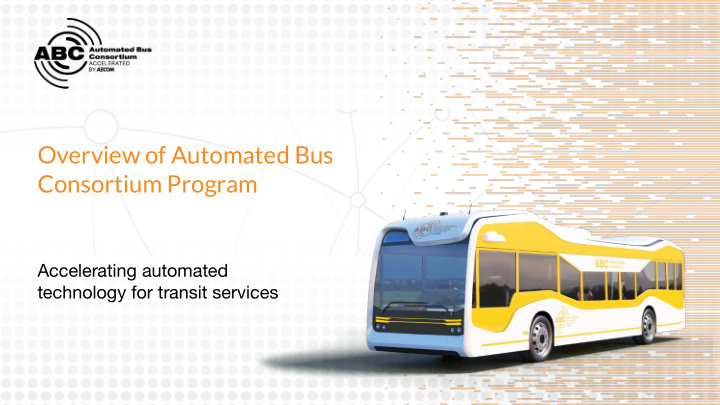



Automated Bus Technology Deployment Program Overview of Automated Bus Consortium Program Accelerating automated technology for transit services
Automated Bus Technology Deployment Program Summary of Concept • Automated small vehicle shuttle technology is proven • Appears feasible to transfer AV shuttle technology to full-sized buses • Vendors need a market to cost-effectively produce these buses • Concept: Joint procurement of 75-100 buses by 12 agencies
Automated Bus Technology Deployment Program Goal of Automated Bus Consortium Project Deploy full-sized, full-speed accessible automated buses: • In a variety of geographies and applications to advance the industry understanding of the technology • Leverage the technology to improve safety, reliability, operating efficiency and customer experience
Consortium Agencies Connecticut Department of Transportation (CTDOT) | Dallas Area Rapid Transit (DART) | Foothill Transit | Long Beach Transit (LBT) | Los Angeles County Metropolitan Transportation Authority (Metro) | MetroLINK (Moline) | Metropolitan Atlanta Rapid Transit Authority (MARTA) | Metropolitan Transit Authority of Harris County (Houston) | Michigan Department of Transportation (MDOT)/Michigan’s mobility initiative, PlanetM | Minnesota Department of Transportation (MnDOT)/Rochester Public Transit | Pinellas Suncoast Transit Authority (PSTA) | Virginia Department of Rail and Public Transportation (DRPT)/Hampton Roads Transit
Proposed Program to Advance Full-Sized Automated Bus Overview of Automated Bus Consortium Program
Automated Bus Technology Deployment Program One Program to Gain Extensive Experience Variety of Applications Variety of Vehicle Options Variety of Geographies • Cold Weather • Bus Rapid Transit • New Vehicles • Desert • Shuttle Service • Retrofit Existing Vehicles • Hot and Humid • Arterial Rapid Transit • Electric Vehicles • Rainy • Express Service • CNG Vehicles • Fixed-Route Service • Diesel Vehicles • Point-to-Point • Maintenance Depot
Committee Structure Overview of Automated Bus Consortium Program
How does the Consortium Work? Consortium Structure Automated Bus • Developed to facilitate decision Consortium making • Success requires participation from each agency at the policy Policy Committee and technical level Planning & Communication and Specifications and Operations Outreach Procurement Committee Committee Committee
Project Communications & Outreach Overview of Automated Bus Consortium Program
Communication and Outreach Program At-a-Glance Local Community National External Press Release Name + Logo Communications Outreach Campaign Toolkit Logo files Regional community Announce the Select name Web site outreach to be Automated Bus and logo defined by the local Consortium Social media Social media agency graphics Press release(s) Templates with Local agency for milestones logo/branding implements program Branded Branded Publicize milestones presentation presentation template
Website – automatedbusconsortium.com
Schedule Overview of Automated Bus Consortium Program
Phased Approached from Feasibility to Implementation 1 2 GO/NO-GO Preliminary Development Agreement Comprehensive Development Agreement • Procurement of Buses • Service Visioning/Pilot Projects • Infrastructure Design • National & Local Outreach • Technology Testing • Vehicle and Infrastructure Technology • Deployment/Construction • Financial Planning • Evaluation • Regulations • Next Steps • Implementation Strategy • Go/No-Go
Automated Bus Consortium Program – Phase 1 Project Schedule: 12 Months
Automated Bus Consortium Phase 2: Implementation Secure Funding Issue RFP for Bus Purchase Vendors Prepare Proposals Evaluate & Award Manufacture Buses Driver Training QA / QC Monitoring Automated Bus Testing Plan National Testing Infrastructure Design Local Testing & Safety Certification Bid & Award Launch Date Planning Infrastructure Construction Construction Management Commence Service Clear Regulatory Requirements Operations & Maintenance Data Management Plan Evaluation Evaluation Plan Strategic Replicability Plan Project Management Outreach: Local & National 2020 2021 2022 2023 2024
Broad Considerations Roadway Characteristics How “cluttered or unpredictable” is the roadway environment? Bus Route Characteristics How complex are the bus’s movements and interactions? External Characteristics What support or resistance is anticipated from stakeholders and partners?
Route Evaluation Criteria ROADWAY CHARACTERISTICS BUS ROUTE CHARACTERISTICS • % of bus route in exclusive lane • Bus stops with pull outs (merge required) • Curb cuts/mile • Number of left-turns on the bus route • Public cross streets/mile • Number of buses to provide service (3 minimum) • Traffic signals/mile • Bus service headways (Peak and off-peak) • Stop signs/mile • Existing average bus passengers/day • Speed limit • Current bus service or planned by 2021 • Average traffic level of service • Bus connections / transfers required • Average daily traffic (ADT) • Right-side boarding • On-street parking along the bus route • ADA accessibility • Construction scheduled in next 2-3 years EXTERNAL CHARACTERISTICS • Pedestrian/bicycle/scooter presence • Adjacent land owner/community support • Roadway grades are within -5% to +5% • Infrastructure costs or availability • Multi-jurisdictional routes – signal interoperability • Supporting institutional partner(s)
Route Selection Matrix BRT BRT Freeway Freeway Arterial Bus Arterial Bus Shuttle Shuttle Agency Yard/Depot (Exclusive Lanes) (Mixed Traffic) (HOT/HOV lanes) (Mixed Flow) (Limited) (Local) (Urban) (Rural) ConnDOT CTfastrak 524 (Love DART Field) 960 (VA DRPT/HRT Beach-Norfolk Exp) 699 Foothill (Montclair-DTLA Exp) Houston 160: Memorial Metro City Express LA Metro Orange Line 45/46: Long Beach Anaheim-PCH-Downt own-CSULB Route 102 (North MARTA Ave/ Little Five Points) MDOT CATA 32/38 Huron MnDOT 18D (TH52) Moline OMC Scherer Dr PSTA Depot
ABC Agency Candidate Pilot Route / Site Presentations • • • • • • • • • • • • •
Pinellas Suncoast Transit Authority (PSTA)
Pinellas Suncoast Transit Authority (PSTA) Route Characteristic Value/Description Route Number/Name 3201 Scherer Dr. Depot PSTA wants to automate their Depot services only. The automated buses could Description deliver parked buses to the operator at the dispatch area and then could leave the bus there for autonomous parking to reduce operator walking time. Length (roundtrip) 0.5 miles Type of Service Yard/Depot Headway (peak) n/a % in Exclusive Lane 100% Daily Ridership (weekday) n/a Operating Speed 5-15 mph Number of Buses Assigned to Route unknown Number of Left Turns n/a EV Readiness (Low, Med, High) High Why This Route/Site?
Recommend
More recommend